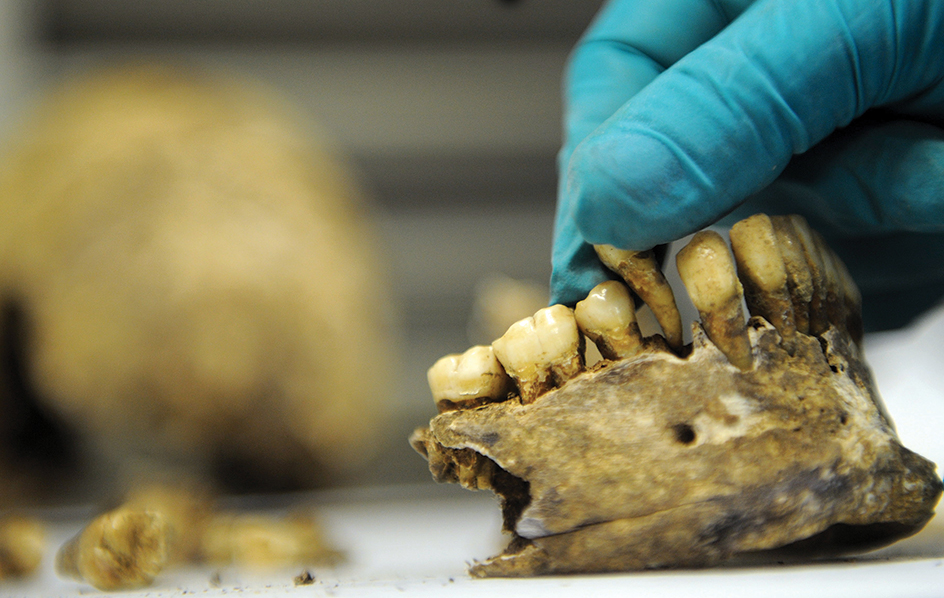Forensic anthropology is the scientific study of human skeletal remains to assist in a legal or humanitarian investigation. Forensic anthropologists often work with law enforcement officials to identify people who died as a result of homicide, suicide, or accident. They also work with humanitarian agencies to identify people who died in disasters or wars. The scientists usually work with remains that are badly decomposed or consist only of bones. They use techniques from the fields of physical anthropology (also called biological anthropology) and archaeology. These techniques enable them to find and recover human remains, identify the dead, and help reconstruct the events leading up to death.

Recovering remains.
Forensic anthropologists may be called when human remains are discovered. In other cases, they may assist in the search for human remains. A forensic anthropologist may find a hidden burial, for example, by examining areas where vegetation has been disturbed, where the ground is uneven, or where there are certain differences in soil color and composition. Once remains are found, forensic anthropologists use the excavation techniques of archaeology to recover them. For example, the scientists record on a map the exact location and position of all bones and other objects, such as clothing or bullets, before these items are removed. This information often proves useful in reconstructing the events leading up to death.
Identifying the dead.
Forensic anthropologists use many techniques to identify the dead. They typically determine the person’s age, sex, height, and ancestry by examining the skeletal remains. Unique features of a particular skeleton, such as evidence of an injury, can assist in identification. Such features may also help determine the cause of death.
For children and adolescents, anthropologists can calculate the age at death by measuring the long bones of the arms and legs. Since long bones grow by means of a structure called the epiphyseal growth plate, located at the ends of the bones [see Bone (Development of bones) ], the amount of bone formation at the ends of long bones can be used to estimate age at death. Forensic anthropologists can also determine age at death by observing which deciduous teeth (also called baby teeth, milk teeth, or primary teeth) and permanent teeth have formed and which have erupted (appeared). See Teeth (table: Ages at which teeth appear) .
For older adults, age at death can be calculated through examination of the bones of the pelvis, the ribs, and the skull, and by examining the teeth. In the skull, for example, the bones grow together in a hard, zigzag joint called a suture. These joints close tighter with age.
Forensic anthropologists determine the person’s sex by examining the shape and configuration of the skull and the pelvic bones and by measuring other bones of the body. However, skeletal differences between females and males usually become recognizable only after puberty. For this reason, it is often impossible to determine the sex of children’s skeletons.
Forensic anthropologists calculate the person’s height from measurements of the long bones of the arms and legs. A variety of features, mainly on the skull, can help determine the ancestry of the dead. Forensic anthropologists also make use of X rays, odontology (the study of teeth and dental work), and other techniques to identify the deceased.
Reconstructing events leading to death.
Forensic anthropologists study the changes that happen to the human body after death. A forensic anthropologist can begin to estimate the time that has passed since death from the condition of the body.
Other evidence can suggest what happened before, during, and after death. For example, forensic anthropologists examine bones for marks that show trauma, such as breaks. They can often tell if a mark was caused by a sharp or blunt impact, a gunshot, or an accident.
History.
Forensic anthropology is a new field of study which relies upon many techniques developed in modern physical anthropology. Forensic anthropology was not formally recognized as a field of study until 1972. In a court of law, forensic anthropologists are responsible for accurately explaining the significance of their evidence. They must be recognized by the court as experts. For this reason, most forensic anthropologists have a Ph.D. degree in anthropology. They generally specialize in the study and analysis of human skeletal remains. Most forensic anthropologists teach at universities. Others are employed by government agencies or by a medical examiner or coroner’s office.
See also Snow, Clyde .
